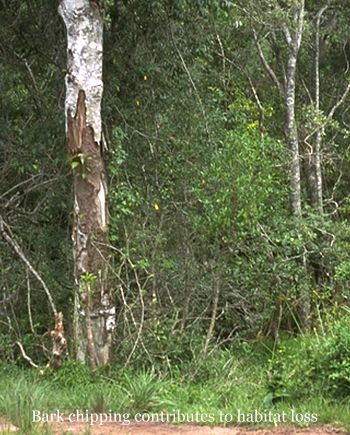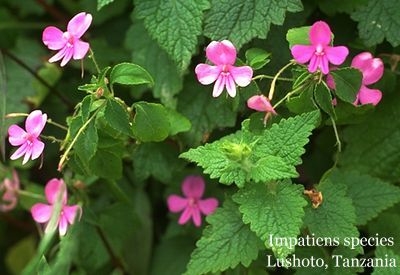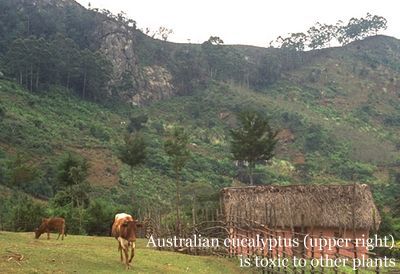 Many Streptocarpus species are extremely threatened by human encroachment. Forests which are critical for their survival, have been the prime target for timber production and supply of firewood. In South Africa and Zimbabwe and even in areas of Tanzania, the reafforestation with exotic pine and blue gum trees also poses a severe threat to Streptocarpus. I visited the Mpumalanga escarpment areas almost ten years ago, in June 1998, and was disturbed to find that some waterfalls at which Streptocarpus grew before were now smothered by pine trees such as the Maria Shire Waterfall between Graskop and Sabie. The surroundings of a well-known roadside population of Streptocarpus cyaneus and Streptocarpus micranthus in the Kowyns Pass, were littered with papers and broken glass by motorists and exotic (Australian) black wattle trees, Acacia mearnsii, were smothering the indigenous tree cover so essential for the survival of these plants.
Many Streptocarpus species are extremely threatened by human encroachment. Forests which are critical for their survival, have been the prime target for timber production and supply of firewood. In South Africa and Zimbabwe and even in areas of Tanzania, the reafforestation with exotic pine and blue gum trees also poses a severe threat to Streptocarpus. I visited the Mpumalanga escarpment areas almost ten years ago, in June 1998, and was disturbed to find that some waterfalls at which Streptocarpus grew before were now smothered by pine trees such as the Maria Shire Waterfall between Graskop and Sabie. The surroundings of a well-known roadside population of Streptocarpus cyaneus and Streptocarpus micranthus in the Kowyns Pass, were littered with papers and broken glass by motorists and exotic (Australian) black wattle trees, Acacia mearnsii, were smothering the indigenous tree cover so essential for the survival of these plants.
 During a visit to the Transkei in January 1999, I also visited Magwa Falls, the home of Streptocarpus johannis and Streptocarpus modestus. To my dismay, the beautiful view shown in the Streptocarpus book by Hilliard and Burtt is now partially obscured by an Australian gum plantation and indigenous trees above the falls, so essential for continued survival of Streptocarpus were being stripped of bark for medicinal purposes and are dying.
During a visit to the Transkei in January 1999, I also visited Magwa Falls, the home of Streptocarpus johannis and Streptocarpus modestus. To my dismay, the beautiful view shown in the Streptocarpus book by Hilliard and Burtt is now partially obscured by an Australian gum plantation and indigenous trees above the falls, so essential for continued survival of Streptocarpus were being stripped of bark for medicinal purposes and are dying.
However, the total removal of all trees as it occurs throughout Africa and Madagascar with complete loss of habitat is the major threat to their continued existence and the long-term survival of Streptocarpus species in many areas is poor. In South Africa, this process has unfortunately recently been accelerated and prime Streptocarpus habitat in Transkei and Kwazulu-Natal is more threatened than ever before. This is the result of increased demand for land for subsistence agriculture and a breakdown of nature conservation services in certain areas. Recently, a new forestry bill was passed in the South African parliament, banning the removal of indigenous trees. Only time will tell whether this will become reality or remain a politician’s dream.
 In September 1996, I visited areas around Lushoto, a town in the Western Usumbara Mountains in Tanzania with the hope of viewing Streptocarpus species. I walked around the highest peak, Mugamba Peak, and to my joy was able to find some Streptocarpus glandulosissimus [* link to image] and Streptocarpus pallidiflorus [* link to image], growing in association with some beautiful Impatiens species [*, will supply pic]. The top of the peak had obviously previously been naturally forested but now a row of Australian eucalyctus trees had been planted across the top [*, will supply pic]. These trees produce toxic substances inhibiting the growth of all vegetation below them and the plants were already showing considerable strain. The vegetation had furthermore been burnt in an effort to clear vegetation for agricultural purposes. The high lying areas of Tanzania have always been under human pressure since colonial times because they were relatively free of malaria, but as a result they are now under extreme pressure for farming purposes by subsistence farmers.
In September 1996, I visited areas around Lushoto, a town in the Western Usumbara Mountains in Tanzania with the hope of viewing Streptocarpus species. I walked around the highest peak, Mugamba Peak, and to my joy was able to find some Streptocarpus glandulosissimus [* link to image] and Streptocarpus pallidiflorus [* link to image], growing in association with some beautiful Impatiens species [*, will supply pic]. The top of the peak had obviously previously been naturally forested but now a row of Australian eucalyctus trees had been planted across the top [*, will supply pic]. These trees produce toxic substances inhibiting the growth of all vegetation below them and the plants were already showing considerable strain. The vegetation had furthermore been burnt in an effort to clear vegetation for agricultural purposes. The high lying areas of Tanzania have always been under human pressure since colonial times because they were relatively free of malaria, but as a result they are now under extreme pressure for farming purposes by subsistence farmers.
 The Tanzanian Government in association with overseas aid agencies is attempting to limit the deforestion by actively planting exotic trees for firewood purposes. This will certainly be contributing to reducing pressures on the natural forests for firewood but brings associated problems caused by alien trees that grow without natural predators and overwhelm the indigenous vegetation, as we have seen all too often in South Africa.
The Tanzanian Government in association with overseas aid agencies is attempting to limit the deforestion by actively planting exotic trees for firewood purposes. This will certainly be contributing to reducing pressures on the natural forests for firewood but brings associated problems caused by alien trees that grow without natural predators and overwhelm the indigenous vegetation, as we have seen all too often in South Africa.
Only time will tell whether the plight of the Streptocarpus and Saintpaulia growing there will be recognized before they are all wiped out. In my opinion all growers of Streptocarpus and Saintpaulias should in some way try to contribute to the conservation of these beautiful plants in nature.
